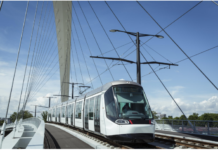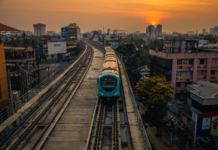Railway Infrastructure has been acting as the backbone of India because of its accessibility and capability to serve each domain of society. In addition, this massive railway infrastructure is also contributing to the growth and economic performance of the country. The improved quality of the results leads to increased employment opportunities, access to market and materials, improved quality of life and empowerment of vulnerable sections.
Acknowledging the importance of railway infrastructure, the Government shifted its focus to continuing investment and gradually increasing its pace to deliver better infrastructure that can not only address the growing demand of commuters but also help the nation to meet its economic goals.
Asset Monetisation in Railways
Asset monetisation in the railway sector constitutes the strategic process of deriving value from existing railway assets to generate revenue without the outright sale of these assets. This approach involves facilitating investment, operation, or development of these assets by private or public entities through structured agreements such as long-term leases, public-private partnerships (PPPs), or concession contracts.
Why is There a Need for Monetisation in the Railways?
Over the years, the union government has strategically increased the funds for the railway sector to improve the infrastructure and streamline the overall rail operations. For example, in 2025-26, capital expenditure is estimated at Rs 2,65,200 crore, the same as the revised estimate for 2024-25. However, despite the allocation of these substantial amounts, some shortcomings can be effectively addressed by the monetisation of railway assets. It can help to unlock the value of existing railway infrastructure to generate non-fare revenue and reinvest in critical upgrades.
Mobilising Funds for Infrastructure Expansion: Indian Railways has ambitious plans to expand its network and modernise its infrastructure. These require massive capital investment, which can be acquired through the monetisation of railway assets. In addition, it allows IR to use underutilised assets (stations, land parcels, etc.), attract private investment and reduce dependence on budgetary support or borrowings.
Improved Operational Efficiency: Through the inclusion of private firms through Public-Private Partnerships (PPP), the railway sector can improve service quality, introduce innovation and modern management practices and reduce delays in project implementation.
Unlocking Value from Non-Core Assets: Indian Railways owns vast land banks, stations, quarters, and freight terminals. Monetising these assets helps realise their full economic potential, which can further support IR in its endeavours to modernise railway infrastructure.
Achieving Self-Sustainability: With increasing pressure to reduce subsidies and operate on a commercially viable model, monetisation can help in generating steady, long-term revenue and reduce the fiscal burden on the government.
Improving Passenger Amenities and Freight Services: Revenue generated through monetisation can be redirected to modernise passenger coaches and terminals, upgrade safety features and improve logistics and multimodal connectivity.
Provision of Asset Monetisation in National Monetisation Pipeline (NMP):
Monetisation of Assets was considered one of the three pillars for more sustainable infrastructure financing in India under the Union Budget 2021-22. The Budget also envisioned the formulation of a “National Monetisation Pipeline” (NMP) to give guidance to the monetisation programme and investor visibility. NITI Aayog was entrusted to create a National Monetisation Pipeline (NMP) for brownfield core infrastructure assets.
The National Monetisation Pipeline (NMP) was designed to align with the remaining period of the National Infrastructure Pipeline (NIP), spanning four years from FY 2022 to FY 2025. During this period, the total indicative value of assets identified for monetisation under the NMP was estimated at ₹6.0 lakh crore. A sector-wise analysis reveals that a portion of this value is concentrated in just five key sectors, which together account for approximately 83% of the total pipeline. These top five sectors are:
- Roads – 27%
- Railways – 25%
- Power – 15%
- Oil & Gas Pipelines – 8%
- Telecom – 6%
Potential Asset Base for Monetisation
Indian Railways (IR) has about 135,207 kilometres of total track covering a route length of 69,181 km. Indian Railways is actively engaged in enhancing its railway infrastructure to enable efficient freight and passenger transportation. However, substantial capital investment is required to address existing capacity constraints. The Potential Asset Base includes assets owned and operated by the Ministry of Railways (MoR), which entail identified Public Sector Undertakings (PSUs) and other entities under the MoR.
Railway Assets Considered for Monetisation Under NMP
Station Redevelopment Programme
Indian Railways launched the station redevelopment plan to provide world-class passenger amenities, making them hubs of economic development and re-establishing them as the nerve centres of cities. The Railway Station Redevelopment Program, launched by the Government of India, targets the modernisation of 400 stations across the country with a total investment of ₹1 lakh crore.
To streamline implementation, stations have been categorised based on their commercial viability and expected scale of development:
| Category | Number of Stations Criteria | Criteria |
| Tier 1 | 50 | High commercial potential, major cities |
| Tier 2 | 100 | Medium-scale urban nodes |
| Tier 3 | 250 | Smaller stations with basic potential |
Passenger Train Operations under Monetisation Framework
As part of the National Monetisation Pipeline (NMP), Indian Railways has included passenger train operations as one of the asset classes identified for private sector participation. This initiative was strategically placed to attract investment and improve service efficiency through structured public-private partnerships. During the NMP period (FY 2022–2025), around 90 trains (about 60%) were targeted to be made operational under private operators.
Project Scope
The plan involves allowing private operators to run trains on selected routes. Key details include:
- 12 clusters have been identified, covering around 109 origin-destination (O-D) route pairs.
- These routes are expected to support approximately 150 passenger trains.
Despite Indian Railways’ efforts to attract private participation in passenger train operations, the initial tender issued in 2021 received a limited response from the industry. Only two entities, IRCTC and Megha Engineering & Infrastructures Ltd., submitted bids during the financial stage. In response to the muted interest, the Railways revised the bidding terms in 2022 to make the project structure more viable. However, concerns related to ridership risk, high haulage charges, and limited flexibility in fare setting continued to affect investor confidence.
Track, Signalling, and Overhead Equipment (OHE)
As part of the National Monetisation Pipeline (NMP), Indian Railways proposed monetising its existing infrastructure, which includes track, signalling systems, and overhead electrification (OHE) through an Infrastructure Investment Trust (InvIT) model.
The goal was to bundle these assets across selected railway routes into a single monetisable package. Currently, these assets are in regular use by Indian Railways, but there is potential for allowing access to private operators in the future under defined terms.
Private Freight Terminals (PFTs)
Indian Railways manages around 1,246 railway-owned goods sheds, as per the Draft National Rail Plan (NRP) 2020. Under the National Monetisation Pipeline (NMP), a portion of these goods, approximately 265, or 21% of the total, have been identified for monetisation by encouraging private sector involvement in their augmentation and operation.
Monetisation of Track & Allied Infrastructure of the Dedicated Freight Corridor of DFCCIL
DFCCIL, a Public Sector Undertaking operating under the Ministry of Railways, was established in 2006 to mitigate the significant congestion and inefficiency prevalent in India’s existing railway network, particularly concerning freight transportation. The Eastern Dedicated Freight Corridor, which encompasses approximately 1,337 kilometres, has already been commissioned. Conversely, the Western Freight Corridor, stretching 1,506 kilometres, is nearing operational status, with the last section anticipated to be commissioned by December 2025.
Under the National Monetisation Pipeline, it is projected that the Dedicated Freight Corridor Corporation of India Limited (DFCCIL) will monetise 673 kilometres of track. This will be accomplished either through the granting of Transfer of Track (TOT) concessions to private entities or by executing an Infrastructure Investment Trust (InvIT) transaction, with revenue generated in the form of Track Access Charges, commencing from the fiscal year 2024.
The National Monetisation Pipeline has outlined two potential instruments for the monetisation of the dedicated freight corridor:
- Infrastructure Investment Trust (InVIT)
- Carry Operate Transfer (COT) Concession.
Indicative Transaction Structure and Terms: COT Concession
Railway Asset Monetisation Target under National Monetisation Pipeline
The Indian Railways is one of the largest state-owned enterprises in the country, owning vast infrastructure across land, tracks, stations, rolling stock, and utilities. To use this extensive asset base, the Government of India introduced the National Monetisation Pipeline (NMP) in August 2021. The NMP featured a structured framework for monetising core assets over four years from FY 2022 to FY 2025, in alignment with the broader National Infrastructure Pipeline (NIP).
Under this framework, Indian Railways was assigned a monetisation target of ₹1,52,496 crore, which accounts for nearly 26% of the total NMP value of ₹6 lakh crore
Breakdown of Monetisation by Asset Type
The following key asset categories have been identified for monetisation under the Railway component of the NMP:
| S.No. | Asset type | FY22 (₹ Cr) | FY23 (₹ Cr) | FY24 (₹ Cr) | FY25(₹ Cr) | Total (₹ Cr) |
| 1 | Railway station development | 17000 | 29325 | 17575 | 12350 | 76250 |
| 2 | Passenger train operations | – | 7002 | 7212 | 7428 | 21642 |
| 3 | Track – OHE InvIT | – | 18700 | – | – | 18700 |
| 4 | Good Sheds | – | 1575 | 2100 | 1890 | 5565 |
| 5 | Konkan Railway | – | – | 7281 | – | 7281 |
| 6 | Hill Railways | 460 | 170 | – | – | 630 |
| 7 | Dedicated Freight Corridor | – | – | 10089 | 10089 | 20178 |
| 8 | Railway Colonies redevelopment | 350 | 450 | 650 | 800 | 2250 |
| Total (Rs crore) | 17,810 | 57,222 | 44,907 | 32,557 | 1,52,496 | |
Yearly Asset Monetisation Target for Indian Railways
Pipeline phasing – Railway Assets (Rs crore)
Assessing the Progress of Railway Asset Monetisation
Despite comprehensive planning, the initiative to monetise railway assets has not succeeded in generating the anticipated revenue under the National Monetisation Pipeline (NMP). The Indian Railways established an ambitious target of raising ₹1.52 lakh crore through asset monetisation during the NMP period from fiscal year 2021 to fiscal year 2025.
However, the actual revenue generated has fallen short of expectations. According to data provided by the Ministry of Finance in the Lok Sabha on August 5, 2024, Indian Railways has raised only ₹28,717 crore for four years.
Breakdown of total amount:
₹20,417 crore was accrued cumulatively between fiscal years 2021–22 and 2023–24.
An additional ₹8,300 crore was generated in fiscal year 2024–25.
The provided statistics indicate that Indian Railways has not met its target of ₹1.52 lakh crore, falling short by ₹1.23 lakh crore. Furthermore, this situation outlines the complexities of regulation, the lack of a structured framework, and the absence of a dedicated regulator in the sector, all of which have deterred private sector participation.
Challenges Encountered in Monetising the Railway Assets
There are several factors that have hindered Indian Railways from achieving its projected targets for asset monetisation. The following outlines the challenges encountered in the monetisation process, particularly concerning the station redevelopment program and private train operations, which are central to this initiative.
Hurdles in Railway Station Redevelopment Programme:
Lack of a Structured Framework
The redevelopment of railway stations constituted approximately 50% of the total projected revenue from asset monetisation. However, the monetisation framework established for the period from fiscal year 2021 to fiscal year 2025 lacked a thorough consultation process and did not include comprehensive recommendations from the railways. Consequently, this inadequacy hindered its ability to attract private investors effectively.
The Negotiation Gap Between Indian Railways and Private Entities
The private businesses that came forward to develop and operate the railway stations expressed a demand for higher returns on the investment. In addition, they asked for better control over the pricing of tickets and the scheduling of trains. However, Indian Railways was unable to accommodate these demands, which affected the private participation.
PPP vs EPC Model
Initially, the NITI Aayog advocated for the public-private partnership model to implement the station redevelopment program. However, this strategy did not prove effective, as it failed to attract private entities to participate in the project. Subsequently, an alternative approach was adopted, leading to the railway authority awarding projects based on the engineering, procurement, and construction (EPC) model.
Absence of a Regulator
A critical element that deterred private entities from actively engaging in the station redevelopment program is the lack of an independent regulatory authority in the railway sector. This absence has created uncertainty for potential investors, particularly concerning timely financial settlements, fare-related decisions, and a mechanism for conflict resolution. In large-scale projects which involve substantial capital, regulatory transparency is paramount for credibility. However, the current framework places much of the control within the Indian Railway itself.
The Indian Railway Stations Development Corporation (IRSDC) was entrusted with the planning and execution of station redevelopment across the country. This entity was officially wound up in 2022. The dissolution of IRSDC has resulted in a fragmentation of responsibilities among various railway bodies and departments. This shift has also led to uncertainty regarding the continuity of projects.
No Bidders for Private Train Operations
The second major segment of revenue was projected to arise from private train operations as per the National Monetisation Pipeline. Indian Railways was anticipated to generate approximately Rs 21,642 crore between FY 2021- FY 2025. However, the initiative failed to yield the expected funds. In 2021, during the initial tendering process, Indian Railways encountered a weak response from private companies designated to manage train operations. Only two bidders, IRCTC and Megha Engineering & Infrastructures, moved further for the financial bidding phase in 2021.
A senior executive from a prospective bidder said that Indian Railways cannot simultaneously serve as both a competitor and a regulator. There is a clear necessity for an independent technical regulator.
In 2022, Indian Railways implemented regulatory modifications; however, these adjustments did not succeed in attracting participation from private entities.
National Monetisation Pipeline 2.0: An Approach to Addressing the Shortcomings
In Phase 1 of the National Monetisation Pipeline (NMP), the government successfully secured approximately ₹5.65 lakh crore, in contrast to the projected target of ₹6 lakh crore through asset monetisation. However, the performance of the Indian Railways sector did not meet expectations, as it generated funds totalling around ₹28,717 crore against a target of ₹1.52 lakh crore between 2021 and 2025.
Following Phase 1, Finance Minister Smt. Nirmala Sitaraman launched the National Monetisation Pipeline 2.0 in the budget for the current year. NMP 2.0 will span between FY2025 and FY2030. NMP 2.0 with a new target of about 10 lakh crore. NITI Aayog, which is responsible for the framework of NMP 2.0, is adopting a new approach this time for effectively meeting the targets through monetisation.
Ministries to Set Their Own Targets under NMP 2.0
NITI Aayog has directed individual ministries to define their own monetisation targets under the upcoming National Monetisation Pipeline (NMP) 2.0. This approach allows ministries to independently project the monetisation potential of their assets, set timelines, and assume direct accountability for outcomes.
This new framework was a key point of discussion during the April 2025 meeting of the Core Group of Secretaries on Asset Monetisation (CGAM). During the meeting, both the Ministry of Railways and the Ministry of Road Transport and Highways (MoRTH) raised concerns regarding the target-setting mechanisms and the methodology adopted in selecting assets for monetisation under the first phase of NMP. They stressed the need for improved internal consultation and asset mapping, which aligns with practical execution models.
Railways Seeks More Control and Clarity in NMP 2.0
In the previous cycle of the NMP, the Indian Railways focused largely on station redevelopment projects and private participation in passenger train operations. However, senior officials now acknowledge that several of these initiatives were implemented without comprehensive internal discussions or a viable Public-Private Partnership (PPP) framework in place. This often resulted in limited participation from private investors and delays in execution.
Railways to Focus on Commercial Space Leasing in NMP 2.0
In Phase 1, the National Monetisation Pipeline (NMP) did not fully explore the potential of commercial space monetisation, which could have been a major source of revenue. To address this, Indian Railways is now planning to shift its strategy in NMP 2.0 by prioritising the leasing of extra land and commercial areas. This will mainly target busy stations like Mumbai, Delhi, and Chennai, which are seen as ideal locations for attracting private investments in areas such as retail, hospitality, storage, and logistics.
Conclusion
Asset monetisation in Indian Railways remains a transformative yet underutilised strategy to unlock capital and modernise infrastructure. While Phase 1 of the National Monetisation Pipeline (NMP) faced setbacks, generating only ₹28,717 crore against a ₹1.52 lakh crore target, it provided critical insights into policy, regulatory, and structural shortcomings. The NMP 2.0 (FY 2025–2030) aims to rectify these gaps with a more flexible framework
However, several challenges must be addressed to ensure success. These include the absence of an independent regulatory authority to provide investor confidence, unresolved issues around fare control and operational autonomy in private partnerships, and the need for clear, streamlined PPP frameworks. Moreover, internal coordination and asset mapping within Indian Railways require improvement to align monetisation efforts with practical execution. Addressing these hurdles with effective policy reforms and transparent stakeholder engagement will be crucial for NMP 2.0 to realise its full potential and contribute to India’s infrastructure development goals.





